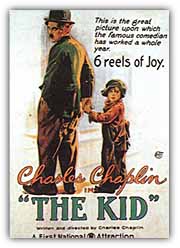|
Part Three: The use of "star presence," starting in the mid-1910s, as a major device for selling films to theater owners and to the public both restricted the individuality of the stars once their persona was fixed and allowed, through practices like block booking, studio heads to exploit stars beyond the films in which they actually appeared.
 If the battle of the Edison Trust and the independents created the star system as a means of product differentiation, the period directly after defined that system. The solidification of the classical style of filmmaking included many techniques which easily permitted, even encouraged, the display of stars: e.g., "The American shot and reverse shot technique was, and essentially remains, a method conceived as a way of enveloping the actors from every side, establishing a formal composition of a minimum complexity within which they may be fairly spontaneous, and even go so far as to completely improvise" (Burch, 114). Through such techniques, which enhanced the seemingly realistic look at stars in a seemingly realistic but not obtrusive space, movie stars were able to participate in the tradition of "fashion" : If the battle of the Edison Trust and the independents created the star system as a means of product differentiation, the period directly after defined that system. The solidification of the classical style of filmmaking included many techniques which easily permitted, even encouraged, the display of stars: e.g., "The American shot and reverse shot technique was, and essentially remains, a method conceived as a way of enveloping the actors from every side, establishing a formal composition of a minimum complexity within which they may be fairly spontaneous, and even go so far as to completely improvise" (Burch, 114). Through such techniques, which enhanced the seemingly realistic look at stars in a seemingly realistic but not obtrusive space, movie stars were able to participate in the tradition of "fashion" :
Fashion itself 'romanticizes,' because it programmatically suggests the forever unattainable, that which always keeps moving out of reach. Its 'reality' is in its acknowledgement of sexual fantasy as a steady force. Used in art, it therefore went a long way in helping to create that Romantic realism which is so dominant in mid-nineteenth-century painting, and which is also the hallmark of all cinema. (Hollander, 260)
In sum, through the techniques of American filmmaking, stars were made to look real and seem extraordinary.
|


 If the battle of the Edison Trust and the independents created the star system as a means of product differentiation, the period directly after defined that system. The solidification of the classical style of filmmaking included many techniques which easily permitted, even encouraged, the display of stars: e.g., "The American shot and reverse shot technique was, and essentially remains, a method conceived as a way of enveloping the actors from every side, establishing a formal composition of a minimum complexity within which they may be fairly spontaneous, and even go so far as to completely improvise" (Burch, 114). Through such techniques, which enhanced the seemingly realistic look at stars in a seemingly realistic but not obtrusive space, movie stars were able to participate in the tradition of "fashion" :
If the battle of the Edison Trust and the independents created the star system as a means of product differentiation, the period directly after defined that system. The solidification of the classical style of filmmaking included many techniques which easily permitted, even encouraged, the display of stars: e.g., "The American shot and reverse shot technique was, and essentially remains, a method conceived as a way of enveloping the actors from every side, establishing a formal composition of a minimum complexity within which they may be fairly spontaneous, and even go so far as to completely improvise" (Burch, 114). Through such techniques, which enhanced the seemingly realistic look at stars in a seemingly realistic but not obtrusive space, movie stars were able to participate in the tradition of "fashion" :




